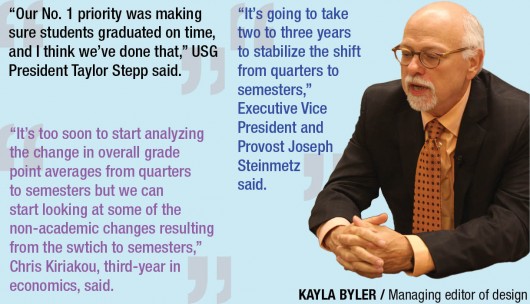
With the second year of semesters under way at Ohio State, some members of the university community feel OSU is still adjusting to a transition that caused campus-wide controversy and confusion.
Executive Vice President and Provost Joseph Steinmetz said he has not looked at the overall grades of the university community since the semester switch and does not think the grades should be analyzed yet.
“It’s going to take two to three years to stabilize the shift from quarters to semesters,” Steinmetz said in an interview with The Lantern Oct. 8. “But it’s just something I haven’t looked at, nor have I heard anything about it one way or another.”
OSU shifted from quarters to semesters at the start of the 2012-13 school year.
Undergraduate Student Government President Taylor Stepp said USG has been involved in the semester transition for a while, particularly with the creation of a semesters appeals board, a project Stepp campaigned for when he first ran for USG president in 2012.
The semesters appeals board, comprised of students, faculty and staff, was created last year to give students an opportunity to address problems they might face as a result of the semester conversion, including damage to academic progress, delay in completing their degree and increased costs in completing their degree, according to Lantern archives.
Stepp said there were many cases in which students had to go through the appeals process, and the process was effective. He said he could not provide the number of students that were helped.
“We had flexibility with the board because students had an individualized approach to having their problems resolved,” Stepp said. “Our No. 1 priority was making sure students graduated on time, and I think we’ve done that.”
Stepp said the semesters appeals board has been a success overall and has been validated by the Office of Academic Affairs.
“We tried to get the word out about the board and I think we did a great job with it. Students had their problems resolved,” Stepp said. “We stopped most of the problems before they became a major issue.”
Stepp said the semesters appeals board will stand until all student academic issues pertaining to the semester switch are resolved.
Chris Kiriakou, a third-year in economics, said it is too soon to make any conclusions about the effectiveness of the semester switch.
“I agree with Steinmetz that it is too soon to start analyzing the change in overall grade point averages from quarters to semesters,” Kiriakou said. “But we can start looking at the some of the non-academic changes resulting from the switch to semesters.”
Kiriakou said some of the consequences of semesters he has experienced are longer lines in the dining facilities compared to when OSU was on quarters, confusing academic curriculum changes, including changes with courses’ content and names, and changing student fees.
For Fall Semester 2013, full-time students owed a $37.50 student activity fee, a $74.40 student union fee, a $13.50 Central Ohio Transit Authority fee and a $123 fee for recreation. For Spring Quarter 2012, full-time students owed a $25 activity fee, a $51 student union fee, a $9 COTA fee and an $82 fee for recreation.
“We don’t have to just look at grade point averages to tell how effective semesters are because there are many other aspects that go into it,” Kiriakou said.
Other students said while they didn’t like semesters last year, they think things are going better this year.
“I didn’t like it very much last year because it was a big change from what I had been used to for two years. I feel better about it this year though because a longer time in the same class allows a better relationship with the professor and that could ultimately result in a better grade for the class,” said Cory Dunn, a fourth-year in nutrition and community health. “I also think it is better to have the same schedule as other schools because we are done earlier and I get to see my friends more from other schools during breaks.”
Tali Lugasy, a third-year in respiratory therapy, said she still isn’t happy about the switch.
“I do not like semesters and I do not think OSU did the transition well,” Lugasy said. “We need to add some sort of break, like a fall break, during the semester because students get so worn out during the 16 weeks.”
Kiriakou, however, said in some ways the semester system seems to be running more smoothly this year than last.
“There is a new batch of students this year who have never experienced the quarter system, so they do not have the ability to compare the two systems or complain about the change,” Kiriakou said.
Stepp said it would be unthinkable to not expect a few issues or mishaps with such a major transition.
“We are all adapting as an institution, both students and faculty,” Stepp said. “We were all expecting for the best, but preparing for the worst.”


